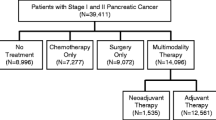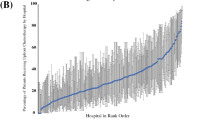Abstract
Background
Multiple prospective, randomized trials have demonstrated that the addition of adjuvant therapy after surgical resection of pancreatic cancer improves survival compared to surgery alone. However, the optimal type of adjuvant therapy, chemotherapy alone, or chemotherapy combined with chemoradiation therapy remains controversial. Our aim was to examine the treatment trends for surgically resectable (stages I and II) pancreatic cancer in the USA using the National Cancer Database.
Methods
The National Cancer Database (NCDB) is a national oncology outcomes database for over 1,500 Commission on Cancer accredited cancer programs. Patients diagnosed with stage I–II pancreatic adenocarcinoma between 2003 and 2010 were selected from the NCDB Hospital Comparison Benchmark Reports. Attention was paid to the initial treatment regimen, such as surgery alone, surgery plus chemotherapy, or surgery plus chemoradiation. In addition, data on hospital setting (teaching hospitals vs. community hospitals) were collected and analyzed. The Cochran–Armitage test for trend was used to assess changes in treatment over time.
Results
Fifty-nine thousand ninety-four patients with stage I–II pancreatic adenocarcinoma were included in the analysis. Between 2003 and 2010, the use of surgery alone as first course treatment of stage II disease decreased significantly at both teaching hospitals and community hospitals among patients who underwent surgery (P < 0.0001 for both cases). In the same period, the use of chemotherapy in addition to surgery as treatment of stage I and II disease increased at least twofold at both hospital settings (P < 0.0001 for all cases). Treatment with surgery plus chemoradiation decreased significantly for both stages in both hospital settings (P < 0.0001 for all cases). Nonsurgical treatment for stage II disease was surprisingly high and significantly increased over time (P < 0.001 for both hospital types), ranging from approximately 30–37 % at teaching hospitals and 39–47 % at community hospitals.
Conclusion
Data from the NCDB from 2003 to 2010 illustrate changes in the adjuvant treatment of pancreatic cancer. The use of chemotherapy alone as adjuvant therapy increased whereas the use of multimodality therapy decreased. In addition, there remains an alarmingly high rate of nonsurgical therapy for stage I and II disease.




Similar content being viewed by others
References
Siegel R, Naishadham D, Jemal A. Cancer statistics, 2012. CA Cancer J Clin 2012; 62:10–29.
Stocken DD, Büchler MW, Dervenis C, Bassi C, Jeekel H, Klinkenbijl JH, Bakkevold KE, Takada T, Amano H, Neoptolemos JP, Pancreatic Cancer Meta-analysis Group. Meta-analysis of randomised adjuvant therapy trials for pancreatic cancer. Br J Cancer 2005;92:1372.
Kalser MH, Ellenberg SS. Pancreatic cancer. Adjuvant combined radiation and chemotherapy following curative resection. Arch Surg 1985;120:899–903.
Neoptolemos JP, Dunn JA, Stocken DD, Almond J, Link K, Beger H, Bassi C, Falconi M, Pederzoli P, Dervenis C, Fernandez-Cruz L, Lacaine F, Pap A, Spooner D, Kerr DJ, Friess H, Büchler MW, European Study Group for Pancreatic Cancer. Adjuvant chemoradiotherapy and chemotherapy in resectable pancreatic cancer: a randomised controlled trial. Lancet 2001;358:1576–85.
Oettle H, Post S, Neuhaus P, Gellert K, Langrehr J, Ridwelski K, Schramm H, Fahlke J, Zuelke C, Burkart C, Gutberlet K, Kettner E, Schmalenberg H, Weigang-Koehler K, Bechstein WO, Niedergethmann M, Schmidt-Wolf I, Roll L, Doerken B, Riess H. Adjuvant chemotherapy with gemcitabine vs observation in patients undergoing curative-intent resection of pancreatic cancer: a randomized controlled trial. JAMA 2007;297:267–77.
Regine WF, Winter KA, Abrams RA, Safran H, Hoffman JP, Konski A, Benson AB, Macdonald JS, Kudrimoti MR, Fromm ML, Haddock MG, Schaefer P, Willett CG, Rich TA. Fluorouracil vs gemcitabine chemotherapy before and after fluorouracil-based chemoradiation following resection of pancreatic adenocarcinoma: a randomized controlled trial. JAMA 2008;299:1019–26.
Neoptolemos JP, Stocken DD, Bassi C, Ghaneh P, Cunningham D, Goldstein D, Padbury R, Moore MJ, Gallinger S, Mariette C, Wente MN, Izbicki JR, Friess H, Lerch MM, Dervenis C, Oláh A, Butturini G, Doi R, Lind PA, Smith D, Valle JW, Palmer DH, Buckels JA, Thompson J, McKay CJ, Rawcliffe CL, Büchler MW, European Study Group for Pancreatic Cancer. Adjuvant chemotherapy with fluorouracil plus folinic acid vs gemcitabine following pancreatic cancer resection: a randomized controlled trial. JAMA 2010;304:1073–81.
National Comprehensive Cancer Network Guidelines Version 2.2012 - Pancreatic Adenocarcinoma. Available at www.nccn.org (Accessed March 28, 2013).
Deyo RA, Cherkin DC, Ciol MA. Adapting a clinical comorbidity index for use with ICD-9-CM administrative databases. J Clin Epidemiol 1992;45:613–9.
Klinkenbijl JH, Jeekel J, Sahmoud T, van Pel R, Couvreur ML, Veenhof CH, Arnaud JP, Gonzalez DG, de Wit LT, Hennipman A, Wils J. Adjuvant radiotherapy and 5-fluorouracil after curative resection of cancer of the pancreas and periampullary region: phase III trial of the EORTC gastrointestinal tract cancer cooperative group. Ann Surg 1999;230:776–84.
Yeo CJ, Abrams RA, Grochow LB, Sohn TA, Ord SE, Hruban RH, Zahurak ML, Dooley WC, Coleman J, Sauter PK, Pitt HA, Lillemoe KD, Cameron JL. Pancreaticoduodenectomy for pancreatic adenocarcinoma: postoperative adjuvant chemoradiation improves survival. A prospective, single-institution experience. Ann Surg 1997;225:621–36.
Seufferlein T, Bachet JB, Van Cutsem E, Rougier P; ESMO Guidelines Working Group. Pancreatic adenocarcinoma: ESMO-ESDO Clinical Practice Guidelines for diagnosis, treatment and follow-up. Ann Oncology 2012;23:33–40.
Hardacre JM, Mulcahy M, Small W, Talamonti M, Obel J, Krishnamurthi S, Rocha-Lima CS, Safran H, Lenz HJ, Chiorean EG. Addition of algenpantucel-L immunotherapy to standard adjuvant therapy for pancreatic cancer: a phase 2 study. J Gastrointest Surg 2013;17:94–101.
Piperdi M, McDade TP, Shim JK, et al. A neoadjuvant strategy for pancreatic adenocarcinoma increases the likelihood of receiving all components of care: lessons from a single-institution database. Journal of the International Hepato Pancreato Biliary Association 2010;12:204–210.
Sohn TA, Yeo CJ, Cameron JL, Koniaris L, Kaushal S, Abrams RA, Sauter PK, Coleman J, Hruban RH, Lillemoe KD. Resected adenocarcinoma of the pancreas-616 patients: results, outcomes, and prognostic indicators. J Gastrointest Surg 2000;4:567–79.
Hardacre JM. Is there a learning curve for pancreaticoduodenectomy after fellowship training? HPB Surg 2010;2010:230287.
Aloia TA, Lee JE, Vauthey JN, Abdalla EK, Wolff RA, Varadhachary GR, Abbruzzese JL, Crane CH, Evans DB, Pisters PW.Delayed recovery after pancreaticoduodenectomy: a major factor impairing the delivery of adjuvant therapy? J Am Coll Surg 2007;204:347–55.
Sener SF, Fremgen A, Menck HR, Winchester DP. Pancreatic cancer: a report of treatment and survival trends for 100,313 patients diagnosed from 1985–1995, using the National Cancer Database. J Am Coll Surg 1999;189:1–7.
Bilimoria KY, Bentrem DJ, Ko CY, Tomlinson JS, Stewart AK, Winchester DP, Talamonti MS. Multimodality therapy for pancreatic cancer in the U.S.: utilization, outcomes, and the effect of hospital volume. Cancer 2007;110:1227–34.
Bilimoria KY, Bentrem DJ, Ko CY, Stewart AK, Winchester DP, Talamonti MS. National failure to operate on early stage pancreatic cancer. Ann Surg 2007;246:173–80.
Lee S, Tzeng CD, Chang GJ, Fleming JB, Lee JE, Katz MH, Jeffrey RL, Hetz SP. Race does not impact pancreatic cancer treatment and survival in an equal access federal health care system. Presented at Society of Surgical Oncology Cancer Symposium, March 6–9, 2013.
Riall TS, Lillemoe KD. Underutilization of surgical resection in patients with localized pancreatic cancer. Ann Surg 2007;246:181–2.
Gordon TA, Bowman HM, Tielsch JM, Bass EB, Burleyson GP, Cameron JL. Statewide regionalization of pancreaticoduodenectomy and its effect on in-hospital mortality. Ann Surg 1998;228:71–8.
Birkmeyer JD, Stukel TA, Siewers AE, Goodney PP, Wennberg DE, Lucas FL. Surgeon volume and operative mortality in the United States. N Engl J Med 2003;349:2117–2127.
Fong Y, Gonen N, Rubin D, Radzyner M, Brennan MF. Long-term survival is superior after resection for cancer in high-volume centers. Ann Surg 2005;242:540–547.
Straus SG, Chen AH, Yee H Jr, Kushel MB, Bell DS. Implementation of an electronic referral system for outpatient specialty care. AMIA Annu Symp Proc 2011;2011:1337–46.
Kim-Hwang JE, Chen AH, Bell DS, Guzman D, Yee HF Jr, Kushel MB. Evaluating electronic referrals for specialty care at a public hospital. J Gen Intern Med 2010;25:1123–8.
Acknowledgments
The author (SR) would like to thank the Case Western Reserve University School of Medicine for providing support with the Dean’s Summer Research Award for first-year medical students.
Author information
Authors and Affiliations
Corresponding author
Additional information
Discussant
Dr. John Allendorf (New York, New York): We know that the patients with pancreatic cancer who do the best and live the longest are the ones who undergo surgical resection and we often lament that only 15 % of patients present with resectable disease. But, Dr. Hardacre and soon to be Dr. Raigani remind us that actually far fewer patients than this actually get to an operating room. Even more startling is the finding that there has been no improvement in the years that have elapsed since Drs. Bilimori and Talamonti brought this to our attention. The authors of this paper should be commended for not letting this issue rest.
I have three questions:
1. Most of the work done on this issue utilizes the national cancer database. Have the authors considered querying other large national databases or large institutional databases to corroborate their findings using similar methods?
2. The overriding bias in this paper, likely held by many of us in the room, is that the reported rate if surgery is unacceptably low. However, the target, acceptable, or appropriate rate of surgical treatment is certainly less than 100 %. Could the authors comment on what they think the appropriate target rate for surgical resection ought to be?
3. Many patients who are radiographically stage I or II by initial CT scan will later be found to be stage III or stage IV by additional imaging or at surgical exploration. So, how does and at what point does the patient get assigned to a stage in the database and how might this affect your results?
Closing Discussant
Mr. Siavash Raigani: Thank you Dr. Allendorf for your comments and questions. We originally set out on this project to assess trends in the adjuvant treatment of pancreatic cancer. We had noticed at our institution that more patients seemed to be getting chemotherapy in the adjuvant setting instead of multimodality therapy. We were therefore interested in seeing if this was a more widespread phenomenon. Our data have shown that it is, but they have also shown the persistence of an inability to get patients with resectable pancreatic cancer the therapy that has the greatest impact on outcome.
With regard to your first question, we are not aware of other national databases that would be able to provide the information needed to corroborate or refute our results. Should anyone know of such a database, we would certainly be interested in doing so.
With regard to staging, the NCDB uses a combined AJCC stage group, which includes the pathologic stage group augmented by the clinical stage group where the pathologic stage is not recorded. This combination minimizes the number of cases without an AJCC stage and avoids exclusion of nonsurgical cases from review.
Finally, you asked what we think an appropriate utilization of surgical resection would be. In this study, ∼20 % of the patients were age 80 or greater. Of that group, one would think that 50–75 % are not appropriate for pancreatic resection. This brings us to 85–90 % of the entire study population. If we subtracted another 5–10 % for patients not amenable to resection, we enter the 75–85 % range, which we think is a reasonable target for a resection rate.
Rights and permissions
About this article
Cite this article
Raigani, S., Ammori, J., Kim, J. et al. Trends in the Treatment of Resectable Pancreatic Adenocarcinoma. J Gastrointest Surg 18, 113–123 (2014). https://doi.org/10.1007/s11605-013-2335-x
Received:
Accepted:
Published:
Issue Date:
DOI: https://doi.org/10.1007/s11605-013-2335-x




